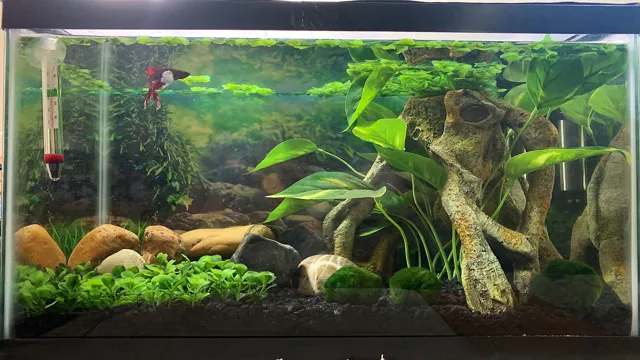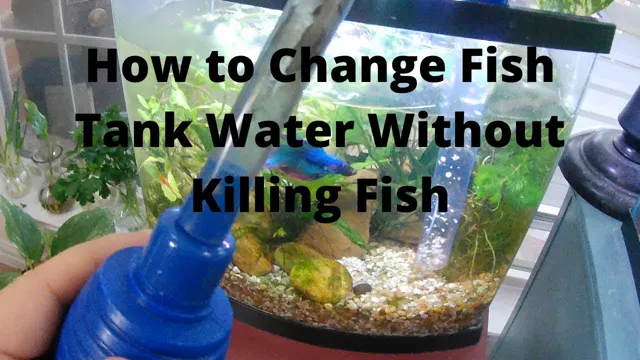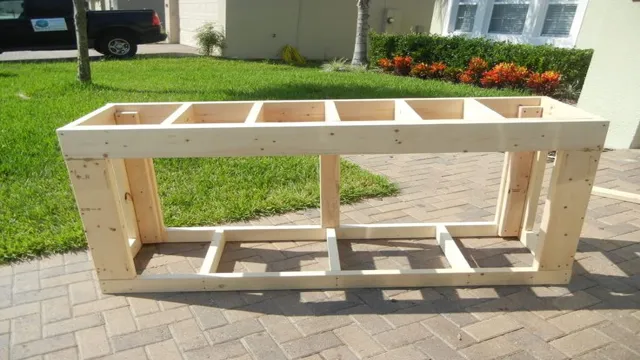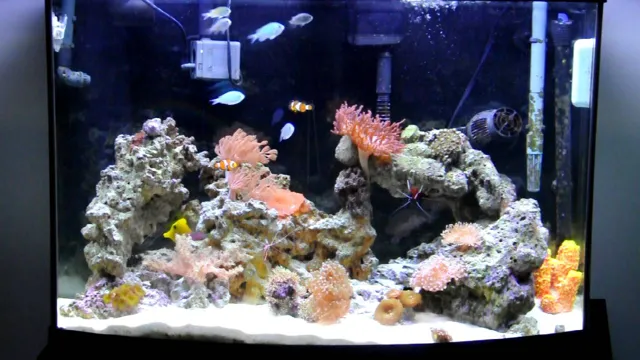Welcome, fellow aquarium enthusiasts! Are you thinking about adding a touch of nature to your indoor space? Building a live plant aquarium is a fun and rewarding experience that can provide both aesthetic and health benefits to your aquatic friends. Not only do live plants offer a more natural-looking habitat for your fish, but they also help regulate the water quality by absorbing nitrates and producing oxygen. Whether you’re a beginner or an experienced aquarist, creating a live plant aquarium requires careful planning and attention to detail.
From selecting the right substrate and lighting to choosing the species of plants that thrive in your aquarium’s environment, there are many factors to consider. But don’t worry! This beginner’s guide will provide you with all the essential information you need to get started on your plant-filled journey. Through this guide, we’ll explore the benefits of live plants in an aquarium, the basics of aquascape design, the types of plants suitable for your aquarium, and tips on how to care for your new aquatic plants.
By the end of this article, you’ll be equipped with the knowledge and confidence to create a beautiful and healthy ecosystem for your aquatic pets, as well as adding a stunning decorative element to your living space. So, grab your aquarium guidebook, your notebook, and your green thumb and let’s dive into the world of live plant aquariums!
Introduction
Are you looking to add some natural beauty to your home decor? Building a live plant aquarium may be just the project for you! Not only are they visually stunning, but live plant aquariums also provide many benefits for the aquatic life within it, including improved water quality and a natural habitat. To get started, you’ll need to choose a suitable tank size, lighting, substrate, and plants. It’s important to research each element thoroughly to ensure that you’re creating a healthy and sustainable environment for your aquatic plants and animals.
Regular maintenance, such as trimming and fertilizing, is also essential for the success of your live plant aquarium. With some patience and dedication, you can create a beautiful and thriving living ecosystem in your own home.
What is a live plant aquarium?
A live plant aquarium is exactly what it sounds like – an aquarium filled with live plants instead of fake ones. These aquariums are becoming increasingly popular for various reasons. First and foremost, live plants in an aquarium can improve the overall health and well-being of the fish living inside.
They provide oxygen, remove toxins, and give the fish a natural environment, mimicking their habitat. Secondly, a live plant aquarium can be a stunning addition to any room, providing a calming and peaceful atmosphere. Imagine a miniature underwater garden in your own home! While maintaining a live plant aquarium can be a bit more work than a traditional one, the benefits far outweigh the effort.
Plus, the satisfaction of creating and maintaining a thriving ecosystem is unmatched. So, if you’re looking to add some greenery to your underwater world, consider a live plant aquarium. Your fish (and your guests) will thank you!

Benefits of having a live plant aquarium
Live plant aquariums are becoming increasingly popular among aquarium enthusiasts. With their numerous benefits, it’s easy to see why. A live plant aquarium can be both visually stunning and beneficial to the health of the fish and other aquatic life it houses.
The presence of live plants can help to oxygenate the water, remove waste and harmful toxins, and create a natural environment for aquarium inhabitants. Additionally, live plants can add an extra layer of natural beauty to your aquarium, enhancing the overall aesthetic experience of owning an aquarium. With all of these benefits, it’s no wonder why many aquarium hobbyists are opting for live plant aquariums over traditional non-living aquarium decorations.
Choosing the Right Equipment
When it comes to building a live plant aquarium, choosing the right equipment is essential. First and foremost, you’ll need a quality aquarium tank that is the appropriate size for your space and the types of plants and fish you want to keep. A filter is also a must-have to ensure clean and healthy water for your aquatic life.
Lighting is another crucial factor to consider, as plants need a specific amount of light to thrive. You’ll want to choose a light that provides enough brightness and color spectrum for your plants without causing excessive algae growth. Additionally, a good substrate will help nourish your plants and support their root systems.
CO2 injection systems can also be beneficial for promoting plant growth, but they are not always necessary. By investing in high-quality equipment, you’ll be well on your way to creating a thriving live plant aquarium.
Aquarium size and shape
When it comes to setting up an aquarium, the right equipment is crucial to ensure the wellbeing of your aquatic pets. Choosing the right aquarium size and shape is the first step in selecting the appropriate equipment for your tank. The size and shape of your tank can affect several factors, such as water circulation and lighting requirements.
It’s essential to consider the type and number of fish you plan to keep, as well as any plants that you might want to include. A larger tank will provide more space for your fish and produce a more stable environment due to a greater water volume, while a smaller tank will require more frequent cleaning and monitoring. The shape of your tank can also impact the ability to create and maintain a showcase aquascape.
A rectangular or square-shaped tank is generally easy to work with and can accommodate a wide range of fish and plants, while a cylindrical or bow-front aquarium presents a unique challenge in terms of arranging decor and equipment. Ultimately, choosing the right aquarium size and shape is a crucial step in creating a healthy, vibrant aquatic environment for your pets.
Lighting
When it comes to lighting for your projects, it’s important to choose the right equipment for the job. One of the most important factors to consider is color temperature. This refers to the color of the light being emitted and can range from warm tones to cool tones.
Warm tones are often used for a cozy and inviting atmosphere, while cool tones are better suited for a modern and crisp feel. Another factor to consider is the type of bulb being used. Incandescent bulbs are popular for their warm glow, but they are not energy efficient. (See Also: How to Lower TDS in Freshwater Aquarium: Tips and Tricks for Crystal-Clear Water)
LED bulbs, on the other hand, are energy efficient and have a longer lifespan. Ultimately, your choice of equipment will depend on your project’s specific needs and the atmosphere you want to create. Remember, your lighting can make or break the overall feel of your space, so choose wisely!
Filtration and water circulation
When it comes to setting up a filtration and water circulation system for your aquarium, choosing the right equipment is crucial for maintaining a healthy environment for your aquatic pets. There are a variety of different options available, including hang-on-back filters, canister filters, powerheads, and wave makers. It’s important to consider the size of your tank, the number and types of fish and plants in it, and your budget when selecting equipment.
Hang-on-back filters are a good option for smaller tanks or those on a budget, while canister filters are better for larger tanks. Powerheads and wave makers can help to improve water circulation and oxygenation, which are important for the health of your aquarium inhabitants. By selecting the right equipment and maintaining it regularly, you can ensure that your aquarium remains a healthy and thriving ecosystem for your fish and plants.
Selecting the Right Plants
When building a live plant aquarium, selecting the right plants is crucial for creating a healthy and aesthetically pleasing underwater environment. It’s important to choose plants that are compatible with the water conditions and lighting available in your tank. Some popular options include java fern, Anubias, and Amazon sword plants, which are known for their hardy nature and low maintenance requirements.
Additionally, it’s important to consider the placement of your plants within the tank, ensuring they have enough space to grow and won’t overshadow other plants. Overall, choosing the right plants is key to creating a thriving live plant aquarium and ensuring your aquatic pets have a comfortable habitat to call home.
Low-Maintenance Plants for Beginners
If you’re a beginner looking for low-maintenance plants, it’s important to select the right ones that fit your lifestyle and needs. Some plants require a lot of care and attention, while others can thrive with minimal effort. It’s important to consider your living conditions, such as the amount of sunlight and humidity in your home, as well as the amount of time you’re willing to dedicate to plant care.
Succulents are a great option for those who don’t have a lot of time or want plants that are easy to care for. They don’t require frequent watering, and they can survive in a variety of light conditions. Snake plants are another popular choice for beginners, as they can grow in low light and don’t require a lot of watering.
Pothos plants are also low-maintenance and can tolerate a range of conditions, including low light and dry air. By selecting the right plants for your lifestyle, you can enjoy the beauty and benefits of greenery without the added stress of high-maintenance care.
Plants for a High-Tech Aquarium
When selecting the right plants for a high-tech aquarium, it’s important to consider various factors. One key factor is the lighting. Plants that require high-intensity lighting won’t do well in a low-intensity system.
On the other hand, plants that are low-maintenance and require minimal lighting won’t thrive in a high-intensity system. Another factor is the nutrients available in the aquarium. Some plants require specific nutrients to grow, while others can thrive on the nutrients naturally available in the water.
It’s also essential to consider the size of the aquarium and the space available for the plants to grow. It’s always best to choose plants that are suited to the specific environment of your aquarium. By selecting the right plants, you can ensure that your high-tech aquarium not only looks fantastic but also provides a healthy environment for your fish to thrive.
So, take the time to research and learn about different plant species, and find the perfect ones for your aquarium setup!
Creating the Aquascape
Building a live plant aquarium can be an exciting project for any aquarium enthusiast. To start, it’s important to consider the size of your tank, as well as the types of plants and fish you want to include. Make sure to choose plants that can thrive in the lighting and water conditions of your aquarium.
Before adding any plants, make sure to properly clean and prepare the tank by removing any debris and adding a substrate layer. It’s important to anchor the plants securely in the substrate, and to create a natural-looking layout that provides hiding places for fish. Adding driftwood or rocks can also enhance the aesthetic appeal of your aquascape.
Once everything is set up, you’ll need to give your plants and fish time to adjust to their new environment. With proper care and maintenance, your live plant aquarium will become a thriving ecosystem that provides beauty and relaxation for years to come.
Planning the layout
Planning the layout of your aquascape is crucial for creating a beautiful and functional ecosystem for your aquatic pets. First, consider the size and shape of your aquarium as well as any external factors such as lighting and filtration. Then, decide on the focal point of your aquascape, such as a rock formation or unique plant.
Use the rule of thirds to create balance and depth in your design, placing your focal point off-center and using negative space to draw the eye around the tank. Experiment with different heights and textures of plants to create natural-looking layers and add interest to your design. Finally, think about the needs of your fish and other aquatic inhabitants, providing hiding places and open swimming areas for them to feel comfortable in their new home. (See Also: How to Clean Aquarium Charcoal: A Step-by-Step Guide to Ensure Safe and Healthy Water)
By carefully planning your aquascape layout, you can create a visually stunning and functional ecosystem that will provide enjoyment for both you and your pets.
Setting up the substrate
When it comes to creating an aquascape, setting up the substrate is an essential step. The substrate is the layer of material that sits at the bottom of the aquarium and provides support for the plants and animal life. To set up the substrate, start by rinsing any gravel or sand you plan to use thoroughly to remove any dust or debris.
Then, layer the substrate at a depth of around 2-3 inches, making sure to create some variation in depth to create a more natural-looking landscape. A good rule of thumb is to create a deeper area at the back of the tank and a shallower area at the front. Once you’ve added the substrate, you can start to add rocks, driftwood, and other decorations to create the desired look and feel for your aquascape.
Remember to keep the main keyword “aquascape” in mind when deciding on the design, and take your time to ensure everything is in the right place before adding any plants or fish.
Adding hardscape elements
Creating the perfect aquascape involves adding hardscape elements that bring your vision to life. Hardscape elements such as rocks, driftwood, and stones add a natural look and feel to your aquarium, mimicking the environment you’re trying to create. These elements not only provide aesthetic appeal but also serve as functional elements to support your plants and provide hiding spaces for your fish.
One popular material used in aquascaping is the use of lava rocks. These rocks are not only visually appealing but also have unique pores that encourage beneficial bacteria growth and improve water quality. In summary, incorporating hardscape elements is an essential step in creating a balanced and complex aquascape.
Planting the plants
Planting the plants is the most crucial step when creating an aquascape. Before placing any plants in the tank, it is essential to plan out the placement of each plant to ensure they complement each other and create a cohesive look. When selecting plants, consider their color, texture, and growth rate.
It is best to choose plants that have a slow or medium growth rate, as fast-growing plants can quickly overtake the tank and become difficult to manage. Once the plants have been selected, carefully plant each one into the substrate, ensuring the roots are covered and firmly planted. It’s crucial to avoid planting them too close to each other as this can lead to competition for nutrients and space.
Remember to consider the lighting and CO2 levels in the tank, as this will affect the growth of the plants. By taking the time to plan and carefully plant each plant, your aquascape will thrive and create a beautiful underwater landscape.
Maintaining Your Live Plant Aquarium
Building and maintaining a live plant aquarium can be a rewarding but challenging experience. The first step in building a live plant aquarium is to choose the right plants for your tank. It’s important to choose plants that thrive in the conditions of your tank, including the lighting, water temperature, and pH levels.
Once you have chosen your plants, it’s important to provide them with the right amount of light, nutrients, and carbon dioxide. Regular maintenance is also important to keep your live plant aquarium healthy. This includes keeping the water clean and balanced, trimming the plants, and removing any debris or dead plants.
With the right care and attention, your live plant aquarium can be a beautiful addition to your home or office.
Water changes and testing
When it comes to maintaining your live plant aquarium, water changes and testing are crucial. Regular water changes ensure that your aquarium’s water is clean and healthy for your plants and fish to thrive. It’s recommended to change up to 25% of the water each week, removing any debris or waste that has accumulated.
Testing the water is also essential, as it helps you to maintain the correct balance of pH, nitrate, and ammonia levels. A drop in pH levels can affect your plants’ ability to grow and thrive, while high levels of nitrate and ammonia can harm your fish. Testing kits are readily available for purchase, making this a simple and easy process.
Maintaining a clean and healthy aquarium requires a little effort and time but will ultimately create a beautiful environment for your live plants and fish to enjoy.
Trimming and fertilizing the plants
Maintaining a live plant aquarium requires careful attention and care when it comes to trimming and fertilizing the plants. Trimming the plants regularly is essential to maintaining their health and ensuring that they do not become overgrown. This process involves cutting back any dead or damaged leaves or stems, as well as removing any excess growth that may be obstructing the tank or blocking the light sources.
It’s important to use sharp scissors or pruning shears to avoid damaging the plant, and to always make clean cuts at a 45-degree angle. In addition to trimming, fertilizing the plants is also crucial. Plants in a live aquarium require nutrients that are essential for their growth and survival. (See Also: How to Balance Light and CO2 in Aquarium for Optimal Plant Growth: Tips and Tricks)
The right balance of nutrients can help promote healthy plant growth, increase oxygen levels in the water, and ultimately improve the overall health of the aquatic environment. It’s important to choose a high-quality plant fertilizer that provides all the necessary nutrients, and to follow the manufacturer’s instructions on how to properly apply it to the tank. Over-fertilizing can be harmful, so it’s important to do it in moderation and monitor the plants for any signs of stress or unhealthy growth.
Maintaining a healthy live plant aquarium requires careful attention and regular maintenance. By ensuring that you keep your plants trimmed and fertilized, you can create a beautiful and thriving aquatic environment that fosters the growth and health of all its inhabitants. So, ensure that you take the necessary steps to care for your live plants, and they will reward you with healthy growth and stunning beauty.
Algae control
Algae control in a live plant aquarium can be a daunting task, but with proper maintenance, it can easily be managed. One way to control algae growth is by ensuring that the lighting in the tank is not left on for extended periods of time. The recommended time frame for lighting should be around 8-10 hours per day.
Overfeeding the fish can also contribute to algae growth, so it’s important to only feed what the fish can consume in a few minutes. Another effective method of algae control is by conducting regular water changes to remove any buildup of excess nutrients in the water. It’s important to maintain a proper balance of nitrogen and phosphorus in the water to prevent excessive algae growth.
Another way to control algae is by introducing algae-eating fish, like Siamese algae eaters or certain species of catfish, into the tank. These types of fish can help to naturally keep algae growth in check. By implementing these simple methods, maintaining a healthy live plant aquarium can be easily accomplished, with minimal algae growth.
Conclusion
In conclusion, building a live plant aquarium is like creating a mini underwater garden in your own home. It requires patience, creativity, and a keen eye for detail. With the right tools, knowledge, and determination, you can transform your aquarium into a beautiful and thriving ecosystem that not only adds beauty to your home, but also provides a serene and peaceful space for your fish and plants to grow and thrive.
So, dive in and start building your own live plant aquarium today – your underwater paradise awaits!”
FAQs
What materials are needed to build a live plant aquarium?
To build a live plant aquarium, you will need a tank, substrate, lighting, filter, heater, and live plants.
How much lighting do live plants in an aquarium require?
Live plants in an aquarium require around 8-10 hours of light per day. It is best to have a timer to ensure consistent lighting.
What is the best substrate for a live plant aquarium?
The best substrate for a live plant aquarium is a nutrient-rich substrate, such as fluval stratum or ADA aquasoil. These substrates provide plants with essential nutrients needed for growth.
Do live plants in an aquarium require CO2 injection?
While not always necessary, injecting CO2 into your aquarium can greatly benefit the growth and health of your live plants. This is because CO2 is essential for the process of photosynthesis.
How often should I fertilize my live plants in an aquarium?
It is recommended to fertilize your live plants in the aquarium once or twice a week, depending on the specific fertilizers used. Be sure to avoid over-fertilization, as this can harm both the plants and your aquarium’s inhabitants.
Can I have fish in a live plant aquarium?
Yes, fish can coexist with live plants in an aquarium. In fact, having fish in your aquarium can provide natural fertilization for the plants.
Do I need to prune my live plants in an aquarium?
Yes, as live plants grow, they will require pruning to prevent overcrowding and to promote healthy growth. Be sure to use proper techniques and tools to avoid damaging the plants.







